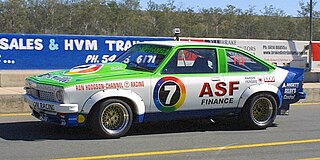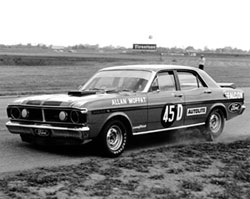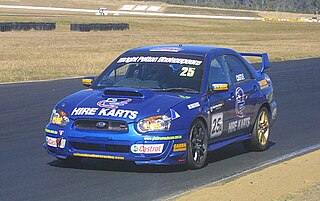
Australian Formula 2, sometimes abbreviated to AF2 or ANF2, is a "wings and slicks" formula racing category in Australia. The category is one of Australia's oldest, dating back to 1964. The current format of AF2 was introduced in 1978. Brian Shead of Cheetah Racing Cars and Garrie Cooper of Elfin Racing Cars were largely responsible for the development of the format, which was devised to suit the needs of Australian drivers, most of whom had little or no sponsorship and had to bear the costs of racing out of their own pockets.

In relation to Australian motorsport, Group C refers to either of two sets of regulations devised by the Confederation of Australian Motor Sport (CAMS) for use in Australian Touring Car Racing from 1965 to 1984. These are not to be confused with the FIA's Group C sports car regulations, used from 1982 to 1992 for the World Endurance Championship / World Sports-Prototype Championship / World Sportscar Championship and the 24 Hours of Le Mans.
The National Series for Sports Sedans, formerly the Australian Sports Sedan Championship, is a CAMS sanctioned national motor racing title for drivers of cars complying with Australian Sports Sedan regulations. This class, essentially a silhouette racing car class, caters for cars of essentially free construction but utilising some of the bodywork of a closed, series production vehicle.

The Australian Sports Car Championship was the national title for sports car racing drivers sanctioned by the Confederation of Australian Motor Sport from 1969 to 1988. Each championship was contested over a series of races with the exception of the 1975 title, which was awarded on the results of a single race held at the Phillip Island circuit in Victoria.
Australian Formula 3 has been the name applied to two distinctly different motor racing categories, separated by over twenty years.

The Australian GT Championship is a CAMS-sanctioned national title for drivers of GT cars, held annually from 1960 to 1963, from 1982 to 1985 and from 2005. Each championship up to and including the 1963 title was contested over a single race and those after that year over a series of races. The categories which have contested the championship have not always been well defined and often have become a home for cars orphaned by category collapse or a sudden change in regulation.

Australian Formula 1 (AF1) was a motor sport category for open-wheeler racing cars which was current in Australia from 1970 to 1983.
The 1984 Australian Sports Car Championship was an Australian motor racing title open to Sports Cars complying with CAMS Group A regulations. It was the 16th Australian Sports Car Championship.

Kaditcha was an automobile manufacturer in Australia. The company, formed by Queensland engineer Barry Lock, made open wheel and sports car racing cars, including cars for Formula 5000, Formula Pacific and Australian Formula 2.

Appendix J Touring Cars was an Australian motor racing category for modified, production based sedans. It was the premier form of Touring car racing in Australia from 1960 to 1964.
The Australian 1½ Litre Formula was a motor racing category which was current in Australia from 1964 to 1968. The formula specified racing cars with four-cylinder unsupercharged engines using commercially available fuel and limited to 1500cc capacity. It occupied the second tier in Australian formula car racing, below the Australian National Formula and above Australian Formula 2 (1100cc) and Australian Formula 3 (1000cc).

Group E Series Production Touring Cars was an Australian motor racing category for production based sedans competing with limited modifications. It was current from 1964 to 1972.

Group 3E Series Production Cars is an Australian motor racing formula for production based cars competing with limited modifications. Group 3E cars formerly contested the Australian Manufacturers' Championship and Australian Production Car Championship titles and compete in the annual Bathurst 12 Hour and Bathurst 6 Hour endurance races.
The 1983 Australian Sports Car Championship was a CAMS sanctioned motor racing title for drivers of Group A Sports Cars. It was the fifteenth Australian Sports Car Championship.
The 1985 Australian Sports Car Championship was a CAMS sanctioned motor racing title for drivers of Group A Sports Cars. It was the 17th Australian Sports Car Championship and the first to be run concurrently with the Australian GT Championship.
Group D Production Sports Cars was a CAMS motor racing category current in Australia from 1972 to 1981.
The 1988 Australian Sports Car Championship was a CAMS sanctioned motor racing competition open to Group 2A Sports Cars, FISA C1 cars, FISA C2 cars and Sports Sedans. The title, which was the 20th Australian Sports Car Championship, was contested over a four round series and was won by Alan Nolan, driving a Nola Chevrolet.

Group N Touring Cars is an Australian motor racing category for touring cars built before December 1972.
The 1982 Australian Sports Car Championship was a CAMS sanctioned Australian motor racing title open to Group A Sports Cars. It was the fourteenth Australian Sports Car Championship, and the first to be contested by Group A cars since 1975. The championship was won by Chris Clearihan of Canberra, driving a Kaditcha.
The 1986 Australian Sports Car Championship was a CAMS sanctioned Australian motor racing title for drivers of Group A Sports Cars. It was the 18th Australian Sports Car Championship.










